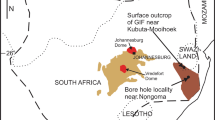Abstract
THE determinations of the radioactivity of a series of ferro-manganese concretions of the seas and lakes of the U.S.S.R.1 (especially of the Kara Sea2 and lakes of Karelia3) have brought out certain facts (the surface layer is more active than the central part, the want or insignificant contents of Th X-MsTh) which make possible the determination of the age of the concretions by the content of radium in its different layers.
This is a preview of subscription content, access via your institution
Access options
Subscribe to this journal
Receive 51 print issues and online access
$199.00 per year
only $3.90 per issue
Buy this article
- Purchase on Springer Link
- Instant access to full article PDF
Prices may be subject to local taxes which are calculated during checkout
Similar content being viewed by others
References
L. M. Kurbatov, NATURE, 136, 871, Nov. 30, 1935.
L. M. Kurbatov, ” Radioactivity of Ferro-Manganese Formations of Kara Sea” (in preparation).
L. M. Kurbatov, ibid.
Author information
Authors and Affiliations
Rights and permissions
About this article
Cite this article
KURBATOV, L. Age of Ferro-Manganese Concretions. Nature 137, 949–950 (1936). https://doi.org/10.1038/137949b0
Published:
Issue Date:
DOI: https://doi.org/10.1038/137949b0
Comments
By submitting a comment you agree to abide by our Terms and Community Guidelines. If you find something abusive or that does not comply with our terms or guidelines please flag it as inappropriate.



